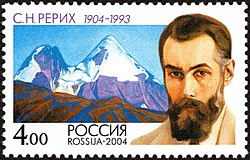Svetoslav Roerich
Svetoslav Roerich | |
|---|---|
 | |
| Born | 23 October 1904 |
| Died | 30 January 1993 (aged 88) |
| Resting place | Bangalore, Karnataka, India |
| Spouse(s) | Devika Rani (1945–1993) |
| Parent(s) | Nicholas Roerich, Helena Roerich |
Svetoslav Nikolaevich Roerich (Russian: Светослáв or Святослáв Никола́евич Рéрих; 23 October 1904 – 30 January 1993), Russian and Indian painter, son of Helena and Nicholas Roerich, studied from a young age under his father's tutelage.[1] He studied architecture in England in 1919 and entered Columbia University's school of architecture in 1920. He won the Grand Prix of the Sesquicentennial Exposition in Philadelphia in 1926.
Biography[edit | edit source]
He lived for many years in India where Jawaharlal Nehru awarded him the International Award and the Padma Bhushan. His paintings of Nehru and Indira Gandhi, adorn the historic Central Parliament Hall in New Delhi. He was married in 1945 to an Indian movie star Devika Rani, who was once married to producer Himanshu Rai and known as "The First Lady of the Indian Screen". Roerich died in 1993 at the age of 88 and is buried in Bangalore, India.[2]
He was named an Honorary Academician of the Art Academy of the USSR, and was an honorary member of the Bulgarian Academy of Art.
He had a large plantation on the outskirts of Bangalore, called Tataguni, on Kanakpura road. He and Devika Rani lived here; after their respective deaths in August 2011, the Government of Karnataka acquired the estate after the Supreme Court of India passed the verdict in favour of them..
Roerich family's residence in Manali, India, is now home for a gallery of paintings. It is managed by the International Roerich Trust and has been named Roerich Heritage Museum. The gallery was founded by Svetoslav Roerich in 1962.[3]
Work[edit | edit source]
Roerich mainly painted landscapes and portraits.[4] His paintings were first exhibited in India in 1936–1937 [5]
His portrait of Indira Gandhi was unveiled in the Central Hall of the Parliament of India.[6]
European art historians have considered his paintings to be influenced by expressionism.[citation needed]
Honours and awards[edit | edit source]
- Padma Bhushan (India) (1961)[7]
- Order of Friendship of Peoples
- Order of Madara Horseman (Bulgaria)
- Awarded Jawaharlal Nehru
- Cavalier of the Order of Cyril and Methodius (Bulgaria)
- Honorary Member of the USSR Academy of Arts
- Honorary Doctor of Veliko Tarnovo University (Bulgaria)
- Academician of the Academy of Fine Arts of India
See also[edit | edit source]
- Roerichism
- Helena Roerich
- Nicholas Roerich
- George de Roerich
- Pax Cultura
- Yuli Mikhailovich Vorontsov — president of International Centre of the Roerichs (Moscow)
- Sree Chitra Art Gallery
References[edit | edit source]
- ↑ Skumin, V. A.; Aunovsky, O. K. (1995). Светоносцы (о семье Рерихов) [The Bringers of the Light (The story of the Roerich family).] (in русский). Novocheboksarsk: TEROS. ISBN 5-88167-004-3. Archived from the original on 24 August 2017. Retrieved 16 January 2015.
- ↑ "SVETOSLAV NIKOLAEVICH ROERICH (RUSSIAN-INDIAN 1904–1993)". shapiroauctions.com.
- ↑ International Centre of the Roerichs
- ↑ "Untitled Document". www.roerich.kar.nic.in.
- ↑ "The Sunday Tribune – Spectrum". www.tribuneindia.com.
- ↑ "Rajya Sabha". rajyasabha.nic.in.
- ↑ "Padma Awards" (PDF). Ministry of Home Affairs, Government of India. 2015. Retrieved 21 July 2015.
External links[edit | edit source]
- Pages using Lang-xx templates
- Articles with unsourced statements from July 2019
- 1904 births
- 1993 deaths
- Painters from Saint Petersburg
- People from Sankt-Peterburgsky Uyezd
- Roerich family
- Russian people of German descent
- Baltic German people of the Russian Empire
- 20th-century Russian painters
- Russian male painters
- 20th-century historians
- Emigrants from the Russian Empire to India
- Emigrants from the Russian Empire to the United States
- People from Kullu
- Roerichism
- Russian explorers
- Russian orientalists
- Painters from Karnataka
- Artists from Bangalore
- Fellows of the Lalit Kala Akademi
- Recipients of the Order of Friendship of Peoples
- Recipients of the Padma Bhushan in arts

